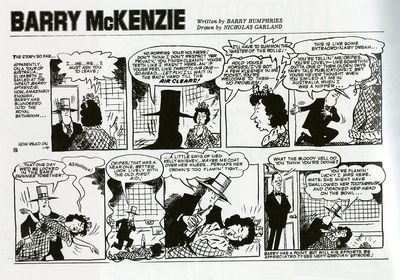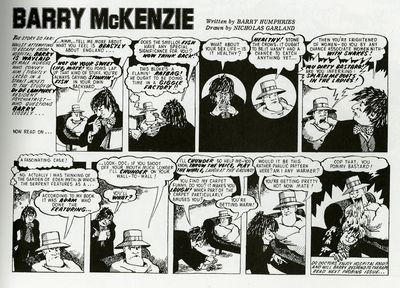Private Eye at the V&A (and in the TLS)
"Every time you go through the pile there might be someone new who's good", says Ian Hislop of his search through the hundreds of cartoons submitted to Private Eye each fortnight. "I always think it's one of the best bits of being editor". Private Eye: The first 50 years, which opened at the V&A on Tuesday, celebrates all those cartoons – "whether savage or simply funny, with or without words" – that have made it on to the page since 1961. The many cartoonists represented include such masters as Willie Rushton, Ralph Steadman and Gerald Scarfe.
In introducing the display, Hislop said that it was important to indulge cartoonists' little obsessions. There are good strips that "come from nowhere and are often about nothing". All cartoonists have their idiosyncratic methods. He referred to "Barry McKenzie" (c.1965–1974), written by Barry Humphries and illustrated by Nicholas Garland, which was suggested by Peter Cook as "an Australian Candide" and became the Eye's first really popular feature. Much of the Australian slang, Hislop told us, wasn't Australian at all: Humphries had made it up.
For more about the idiom of "Barry McKenzie", visitors to the exhibition need look no further than an article, reproduced in part below, entitled "The Living Language", written by Humphries himself and published in the TLS of September 16, 1965.
"From the time . . . we had thought of presenting the adventures of an Australian Innocent Abroad who spoke in the 'fair dinkum sport' jargon which would be most familiar and comprehensible to English readers. However, as the idea grew and the comic strip became popular, Kenneth Tynan, Alan Sillitoe and Bernard Levin numbering among its more distinguished fans, the stereotyped Australianisms and the obsolete Edwardian slang tended to disappear, and the ellipses and euphemisms of true Australian speech took over. For all that, Barry McKenzie is a pastiche figure. His vocabulary is borrowed from a diversity of national types, and words like 'cobber' and 'bonzer' still intrude as a sop to Pommy readers, though such words are seldom, if ever, used in present-day Australia. The character has been theatricalized and heightened in order that he may be accommodated within the marionette world of the strip cartoon, so that although the shattered syntax is most painstakingly recorded, the slang and the euphemisms which it encases are lifted from a wide cross-section of Australian society. We have attempted to preserve the rhythm, colour and texture of modern Australian speech without fixing the character of Barry McKenzie too firmly in an identifiable class. It is sufficient that he is now recognizable to English readers . . .as a familiar expatriate figure; someone they know. Only the baggy trousers and the wide brimmed hat anchor him to an image of the 'stage' Australian, or the Boy from the Bush. Needless to say, if such a figure walked down Collins Street, Melbourne, now, not a few heads would turn.
Barry McKenzie is a puritan eccentric, and among his many idiosyncrasies a desire to pass water at the most inopportune moments has become increasingly manifest. In nearly every episode Barry feels the Call of Nature which gives the strip a superficial resemblance to the paintings of Teniers and his school. McKenzie employs a number of colourful and expressive Australianisms to describe this prosaic function; straining the potatoes, having a snakes (rhyming slang), flogging the lizard, splashing the boots, writing his name on the lawn, pointing Percy at the porcelain, shaking hands with the wife's best friend . . . .
His enormous consumption of gelid Australian beer on an empty stomach has not infrequently led to disaster, and his favourite word to describe the act of involuntary regurgitation is the verb to chunder. This word is not in popular currency in Australia, but the writer recalls that ten years ago it was common in Victoria's more expensive public schools. It is now used by the Surfies, a repellent breed of sun-bronzed hedonists who actually hold chundering contests on the famed beaches of the Commonwealth. I understand, by the way, that the word derives from a nautical expression 'watch under', an ominous courtesy shouted from the upper decks for the protection of those below . . . ."
Private Eye: The first 50 years
October 18, 2011–January 8, 2012
Studio Gallery
Rooms 17a and 18a
Free admission
Cartoons taken from Private Eye – The first 50 years: An A–Z by Adam Macqueen (312pp. Private Eye Productions. £25. 978 1 901784 56 5)
Peter Stothard's Blog
- Peter Stothard's profile
- 30 followers





